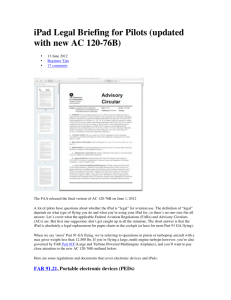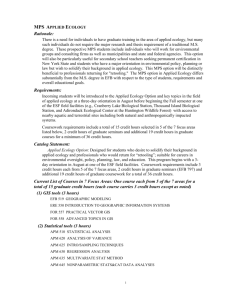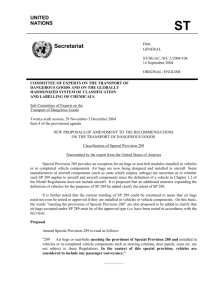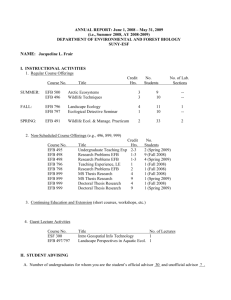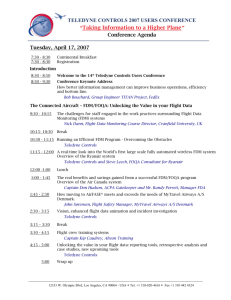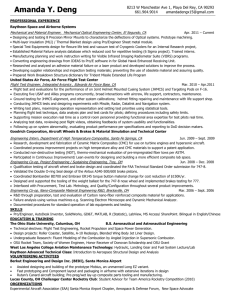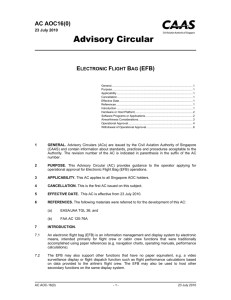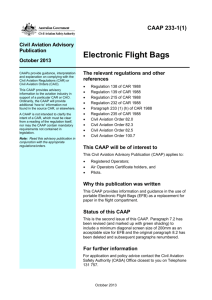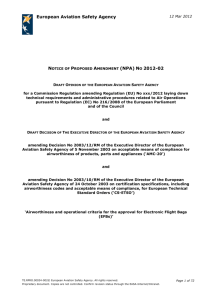FAA Advisory Circular 20
advertisement
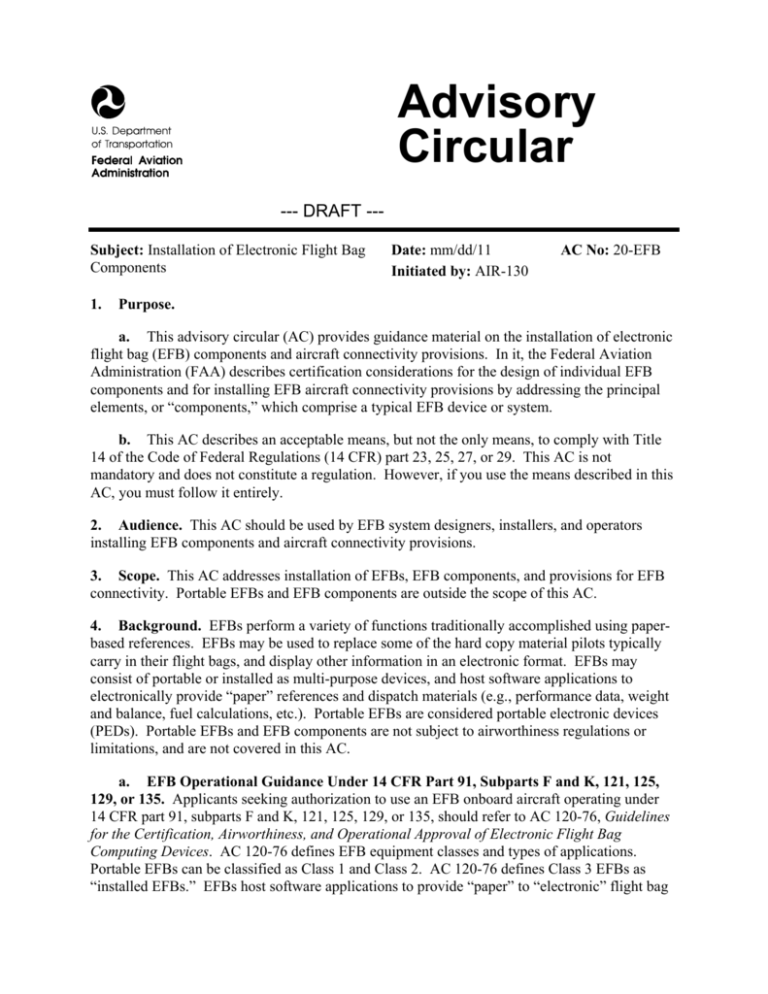
Advisory Circular --- DRAFT --Subject: Installation of Electronic Flight Bag Components 1. Date: mm/dd/11 Initiated by: AIR-130 AC No: 20-EFB Purpose. a. This advisory circular (AC) provides guidance material on the installation of electronic flight bag (EFB) components and aircraft connectivity provisions. In it, the Federal Aviation Administration (FAA) describes certification considerations for the design of individual EFB components and for installing EFB aircraft connectivity provisions by addressing the principal elements, or “components,” which comprise a typical EFB device or system. b. This AC describes an acceptable means, but not the only means, to comply with Title 14 of the Code of Federal Regulations (14 CFR) part 23, 25, 27, or 29. This AC is not mandatory and does not constitute a regulation. However, if you use the means described in this AC, you must follow it entirely. 2. Audience. This AC should be used by EFB system designers, installers, and operators installing EFB components and aircraft connectivity provisions. 3. Scope. This AC addresses installation of EFBs, EFB components, and provisions for EFB connectivity. Portable EFBs and EFB components are outside the scope of this AC. 4. Background. EFBs perform a variety of functions traditionally accomplished using paperbased references. EFBs may be used to replace some of the hard copy material pilots typically carry in their flight bags, and display other information in an electronic format. EFBs may consist of portable or installed as multi-purpose devices, and host software applications to electronically provide “paper” references and dispatch materials (e.g., performance data, weight and balance, fuel calculations, etc.). Portable EFBs are considered portable electronic devices (PEDs). Portable EFBs and EFB components are not subject to airworthiness regulations or limitations, and are not covered in this AC. a. EFB Operational Guidance Under 14 CFR Part 91, Subparts F and K, 121, 125, 129, or 135. Applicants seeking authorization to use an EFB onboard aircraft operating under 14 CFR part 91, subparts F and K, 121, 125, 129, or 135, should refer to AC 120-76, Guidelines for the Certification, Airworthiness, and Operational Approval of Electronic Flight Bag Computing Devices. AC 120-76 defines EFB equipment classes and types of applications. Portable EFBs can be classified as Class 1 and Class 2. AC 120-76 defines Class 3 EFBs as “installed EFBs.” EFBs host software applications to provide “paper” to “electronic” flight bag mm/dd/11 DRAFT AC 20-EFB functionality called Type A and B applications (see AC 120-76, appendices 1 and 2, for listing of example applications). AC 120-76 recognizes there may be other, non-EFB applications, and refers to them as Type C applications. b. EFB Operational Guidance Under 14 CFR Part 91. Applicants intending to operate under 14 CFR part 91 should reference AC 91-78, Use of Class 1 or Class 2 Electronic Flight Bag (EFB). AC 91-78 describes means to remove paper from the cockpit for operations under 14 CFR part 91. c. Airworthiness Applicability. Airworthiness regulations applicable to portable EFBs are limited to the provisions for their installed mounting (including all hardware used to secure the portable device); wiring (both power and data up to, but not including, the portable device); data interface/protection devices; installed ports for connection to aircraft power and data connection; installed wireless communications; and installed antennas. Installation of provisions for portable EFBs requires design parameters for the expected performance of those provisions from the intended portable EFB (i.e., mounting (size and weight), power (maximum electrical load), and data connectivity (input/output specifications and security)). d. EFB System Components. EFB components may be portable or installed as part of aircraft type design. This AC provides design guidance, which addresses those installations that are incorporated into the aircraft type design. Refer to AC 120-76 or AC 91-78 for EFB components which remain portable. Some EFB configurations do not fall neatly into the EFB Class definitions found in AC 120-76. They may have some components installed, but not a complete system, or the hardware is all installed, but is designed to accommodate Type A and B flight bag applications. The applicant is responsible for identifying what components or provisions are installed. This AC is organized around these components. Figure 1 displays the typical EFB system components addressed by the guidance in this AC. Figure 1. Typical EFB System Components Controls (see paragraph 5.f) Mounting (see paragraph 5.a) Software (see paragraphs 5.e and 6.b) Display (see paragraph 5.d) A/C Power Processor (see paragraph 5.e) Data Connectivity Interface Device (see paragraph 5.c) Power Supply (see paragraph 5.b) 2 Data mm/dd/11 5. DRAFT AC 20-EFB Guidance for Individually Installed EFB Components. a. Mounting Devices. This section applies to mounting devices intended to hold EFB equipment. The design of the EFB display mounting devices must address applicable airworthiness regulations (e.g., flammability). EFB mounting devices (or other securing mechanism) may include arm-mounted, cradle, yoke mounts or clips, or docking-stations. Positioning must not obstruct visual or physical access to aircraft controls and displays, flightcrew ingress or egress, or external vision. Consider the following design practices for installation: (1) Accessibility. The mount and associated mechanism should not impede the flightcrew in the performance of any task (normal, abnormal, or emergency) associated with operating any aircraft system and must not compromise the intended function of other installed equipment. (2) Locking. Adjustable mounting devices should be able to lock in position easily. When designing locking positions, accommodate a range of flight crewmember preferences and the expected range of users’ physical abilities (i.e., anthropometric constraints). Locking mechanisms should be of the low-wear type, which minimizes slippage after extended periods of normal use. Mounting design must address the 14 CFR § 25.789 requirements for the retention of items of mass for the expected load factors anticipated when in use, (3) Crashworthiness. Consider crashworthiness in the design of this device. This includes the appropriate restraint of any device, when in use or stowed. Design must address the 14 CFR § XX.561 requirements for part 23, 25, 27, or 29, as applicable. (4) Mount Stowage. If appropriate, provide a means to secure, lock, or stow the mount in a position out of the way of flight crewmember operations when not in use. (5) Mount Cabling. If the EFB requires cabling to mate with aircraft systems or other EFBs, and if the cable is not run inside the mount, the cable should not hang loosely. Flight crewmembers should be able to easily secure the cables out of the way during aircraft operations (e.g., cable tether straps). Cables external to the mount should be of sufficient length to perform the intended tasks. Cables too long or short could present an operational or safety hazard. For part 25 airplanes, these cables are considered electrical wiring interconnection systems (EWIS) and therefore need to comply with 14 CFR part 25, subpart H, and 14 CFR § 26.11. (6) Yoke Mounts and Clips (as described in 14 CFR part 23). Applicants and operators should be aware of unsafe conditions potentially created when attaching a portable EFB to the control yoke with an attachment mechanism, mounting device, or clip. For example, the weight of both the EFB and mounting bracket may affect flight control system dynamics or warning indications, such as stall warning stick shaker; even though the mount alone may be light enough to be insignificant. The mass, moment of inertia, as well as the physical size of the combined mount and EFB, can all contribute to potential unsafe conditions which may require design changes to flight controls and additional flight testing upon installation. 3 mm/dd/11 DRAFT AC 20-EFB (7) Yoke Mounts and Clips (as described in 14 CFR parts 25, 27, and 29). Yoke mounting of an EFB is not recommended. All yoke mounting provisions (i.e., mounts, brackets, clips, etc.) for the EFB must be incorporated into the aircraft type design. The additional weight and other effects (i.e., size, weight, control travel, etc.) of the mount or clip may require design changes to flight controls and additional flight testing upon installation. Note: When the EFB mounting device is not intended for a specific EFB model, document the demonstrated performance parameters for the mounting device (e.g., weight parameters) in the airplane or rotorcraft flight manual (AFM/RFM), airplane or rotorcraft flight manual supplement (AFMS/RFMS), operating manual, or instructions for continued airworthiness (ICAs), as appropriate. (8) Use of Velcro. We do not recommend use of Velcro type hook and loop fastener material for mounting or securing the EFB to a mount, or the aircraft, because the closure strength of Velcro degrades with each use. The cycle life, which is the number of times the hooks and loops can be engaged and disengaged before the closure strength is reduced to 50% of original values, cannot be accurately tracked without a maintenance action. If using Velcro for installed EFB mounts: (a) The ICAs must identify inspection intervals, inspection process, and replacement intervals. (b) The AFM/RFM or AFMS/RFMS must address the procedure for fastening the Velcro to restrain a portable EFB. (c) Ensure the installed Velcro is able to perform its intended function (e.g., retain a portable EFB of specific size and weight) when the Velcro has reached its maximum inspection interval. b. Power Provisions. This section applies to design considerations for installing power provisions for portable EFBs. Install EFB power provisions addressing applicable airworthiness regulations. Design EFB power provisions to include: (1) Installed Switch. Provide a means for a clearly labeled on/off switch for de-powering the power outlet. Note: The use of a circuit breaker as a means of de-powering a function is not acceptable since the repeated use of circuit breakers as switches can degrade their performance and prevent them from actuating at the rated current trip point. (2) Fault Protection. Include fault protection features for monitoring the health of fault detection circuits. If a fault is detected, the power to the outlet should be automatically removed. Automatic reset features should not be permitted. 4 mm/dd/11 DRAFT AC 20-EFB (3) Power Source. Connect EFB power provisions to non-essential or least critical power busses so failure or malfunction of the device, or power supply, will not affect safe operation of critical or essential systems. Connection to more critical aircraft power buses is permitted if the intended function of the EFB warrants, but the ability of the crew to de-power the outlet for the EFB is paramount and must be addressed. (4) Outlet Labeling. Label aircraft electrical outlets to identify the electrical characteristics (e.g., 28 VDC, 115 VAC, 60 or 400 Hz. etc.) to address equipment sensitivity to voltage, current, or frequency parameters and to provide awareness to the flightcrew or maintenance personnel, reducing the likelihood of connecting incompatible devices to the power source. Given the variety of outlet and connector types used for various power sources and the variety of plug adapters available, outlet type alone is not considered to be sufficient. The labeling placard must be legible, easy to see, and as close as practicable to the electrical outlet. The labeling placard should not impose any limitations on the portable EFB itself, which is the operator’s responsibility. c. Data Connectivity with Aircraft Systems (Wired or Wireless). This section applies to interfacing with portable and installed EFBs. Typically, installed EFBs will have the interface protection built into the installed EFB component, while portable EFBs must have a separate data connectivity provision installed in the aircraft. All EFBs using data connectivity provisions to aircraft systems must incorporate an interface protection device (e.g., physical partitioning or read-only access) to ensure data connection required by the device, and its software applications, have no adverse effects on other aircraft systems. EFBs having data connectivity to aircraft systems; either wired or wireless, may read or transmit data to and from aircraft systems, provided the connection and interface protection device is incorporated into the aircraft type design. This connectivity includes data bus and communication systems access (e.g., through an avionics data bus, server, network interface device, or wireless network). Use the following guidance for read-only and transmit-receive data interface protection devices: (1) Read-only Access. The design of interface protection devices that provide read-only access must ensure protection by using one-way communication of data. (2) Transmit-Receive Access. The design of interface protection devices that provide transmit (talk) and receive (read) capability must include: (a) Partition. The design must provide a means to partition Type A and B applications that have not been approved from installed systems on the aircraft. (b) Non-Interference. The design must include a means to ensure that EFB operation, malfunction, or failure does not adversely affect other installed aircraft systems to which connection is made. Design interface protection devices enabling connection of EFBs to existing aircraft equipment, systems, data buses, or networks to address any potential vulnerability and threats in terms of computer viruses, worms, unauthorized access, and malicious access. 5 mm/dd/11 DRAFT AC 20-EFB d. Display. This section provides design guidance for the installation of EFB displays. Guidance on portable displays is not covered in this AC, but may be covered in AC 120-76 or AC 91-78, as applicable. (1) Placement. Placement for EFB displays must address the 14 CFR § XX.773 requirements for parts 23, 25, 27, and 29. Placement also needs to consider many other factors: accessibility, workload effects, and potential pilot fatigue effects from use, etc. Pilot compartment view considerations include glare, reflection, and visual field. For applicants seeking compliance under 14 CFR § 25.773 for installed displays, flight testing in day and night conditions is the acceptable method to find compliance for these issues. Applicants may develop equivalent level of safety (ELOS) justifications for alternative means of compliance, provided they are formally requested and agreed to by the FAA in advance. (2) Screen Size and Resolution. When utilizing the EFB to replace paper products, the screen size and resolution should be designed to display information in a comparable manner to paper aeronautical charts and the data it is intended to replace. For example, the screen should be able to display an instrument approach procedure (IAP) chart in an acceptable aeronautical chart format similar to a published paper chart. The screen should be large enough to show the entire IAP chart at once, with the equivalent degree of legibility and clarity as a paper chart. This is not meant to preclude panning and zooming features, but is intended to prevent a workload increase during the approach phase of flight. Alternate representations of IAP and other navigation charts will need to be evaluated. (3) Recommended Display Standards. Installed EFBs are multipurpose display devices and should follow the design standards found in TSO-C113, Airborne Multipurpose Electronic Displays. For part 25 airplanes, display characteristics listed in AC 25-11, Electronic Flight Deck Displays, are applicable. For part 23 airplanes, apply all display characteristics listed in AC 23.1311-1, Installation of Electronic Display in Part 23 Airplanes. For other aircraft without corresponding criteria, the guidance in AC 25-11 or AC 23.1311-1 serves as recommended design guidance. e. Processor and Partitioning. Installed EFBs may be packaged in various configurations, including a single processor, or a partitioned architecture with multiple operating systems (OS) and multiple processors. Partitioning for an installed EFB should be done via hard-partitioning with physical separation between OSs, processors, etc. A typical partitioned EFB contains two separate systems feeding into a common installed display with a commercial-off-the-shelf (COTS) processor and OS hosting EFB Type A/B applications, and a certified processor and OS environment for approved software applications. Both environments may be resident in the same equipment and feed into a common display device with a certified integration capability between the separate environments to integrate display of application data. EFB configurations include: (1) EFBs Hosting Only Type A/B Applications. Installed EFBs may be designed with the intent to host only EFB Type A/B applications. This configuration would usually identify the hardware installed as miscellaneous, nonrequired equipment. The host environment OS and Type A/B applications are not installed, and may be loaded by the manufacturer or operator. 6 mm/dd/11 DRAFT AC 20-EFB Note: Installed EFBs may use the guidance contained in AC 20-159, Obtaining Design and Production Approval of Airport Moving Map Display Applications Intended for Electronic Flight Bag Systems, to host the airport moving map display (AMMD) software application. As described in AC 20-159, the AMMD application is designed to reside with the Type A/B applications found in the EFB and does not have to be installed. (2) EFBs Hosting Type A/B Applications and Approved Software. Installed EFBs may be designed with the intent to host EFB Type A/B applications as well as providing an environment for installation of approved software as part of aircraft type design. Approved software applications require FAA design, production, and installation approval and can include intended functions for flight displays, communications, navigation, and surveillance. This EFB configuration would usually include multiple OSs, multiple processors, and use partition or protection devices (e.g., physical partitioning) to prevent the hosted Type A/B applications from having any adverse effects on the approved software and other aircraft systems. (3) Type A/B Applications Installed as Approved Software. Historically, operators have chosen to utilize EFB Type A/B applications which were not installed, to reduce certification costs. However, it is acceptable to develop approved software to perform Type A and B applications. For example, software with an airworthiness approval performing an aeronautical charting application could be utilized to support operational requirements without further operational evaluation for use provided the intended function has been evaluated for replacement of paper products. f. Controls. In choosing and designing input devices for installed EFBs, such as keyboards or cursor control devices, designers should consider the type of entry to be made and flight deck environmental factors, such as turbulence, which could affect the usability of the input device. We recommend use of AC 20-CNTL, Controls for Flight Deck Systems[will be corrected prior to publication], to demonstrate the equipment user interface meets controls-related requirements on aircraft flight decks from primarily a human factors perspective. g. Rechargeable Lithium Batteries. Rechargeable lithium batteries (typically lithium-ion and lithium-polymer (lithium-ion polymer)) have higher energy levels, so it is important to take precautions in their use. If mistreated, or not manufactured and maintained to industry safety standards, rechargeable lithium batteries can become hazardous. The use of rechargeable lithium batteries in portable devices is the responsibility of the operator. 6. Guidance Applicable to All Installed EFB Components. a. Hardware. For devices which are intended for non-EFB applications, develop the airborne electronic hardware using AC 20-152, RTCA, Inc., Document RTCA/DO-254, Design Assurance Guidance for Airborne Electronic Hardware, for EFB hardware provisions being installed which include complex custom airborne electronic hardware components. This guidance is applicable if the component’s failure condition classification is major or higher. For components with failure classification of minor, an existing design assurance practice may be 7 mm/dd/11 DRAFT AC 20-EFB used. The design assurance level must be consistent with the failure condition classification for the intended function. (1) Environmental Qualification. Ensure the environmental qualification of installed EFB components is appropriate using AC 21-16, RTCA/DO-160 Versions D, E, F, and G,“Environmental Conditions and Test Procedures for Airborne Equipment,” to demonstrate equipment performance in environmental conditions encountered during operation of the equipment in aircraft. (2) Lightning Protection. Ensure installed EFB components meet the lightning requirements of 14 CFR §§ 23.1306, 25.1316, 27.1316, and 29.1316, as appropriate. AC 20136, Aircraft Electrical And Electronic System Lightning Protection, provides an acceptable method to demonstrate appropriate lightning protection. (3) High Intensity Radiated Fields (HIRF). Ensure installed EFB components meet the HIRF requirements of 14 CFR §§ 23.1308, 25.1317, 27.1317, and 29.1317, as appropriate. AC 20 158, The Certification of Aircraft Electrical and Electronic Systems For Operation In The High-Intensity Radiated Fields (HIRF) Environment, provides an acceptable method to demonstrate the equipment is protected when operating on an aircraft when the aircraft is exposed to an external HIRF environment. b. Software. Develop approved software using AC 20-115, RTCA, Inc., Document RTCA/DO-178B. The design assurance level of the installed software must be consistent with the failure condition classification for the intended function. c. Failure Condition Classifications. Hazards associated with the malfunction of the EFB will depend not only on the EFB hardware, but also on the functionality of the installed software applications running on the EFB. (1) The use of Type A and B applications in portable devices, when accomplished in accordance with AC 91-78 or AC 120-76, as applicable, has been found to provide an acceptable level of safety. (2) If the EFB supports other applications, the failure classification will be driven by those other applications. If the EFB hosts Type A/B applications, adequate partitioning must be provided to ensure the EFB Type A/B applications have no adverse effects on those other applications. We recommend the use of ARP 4754A, Guidelines for Development of Civil Aircraft and Systems, and ARP 4761, Guidelines and Methods for Conducting the Safety Assessment Process on Civil Airborne Systems and Equipment, when developing a partitioned installed EFB system and showing compliance with airworthiness regulations. For primary safety assessment guidance please refer to the system design documents for each aircraft type: (a) AC 23.1309-1, System Safety Analysis and Assessment for Part 23 Airplanes. (b) AC 25.1309-1, System Design and Analysis. (c) AC 27-1, Certification of Normal Category Rotorcraft. 8 mm/dd/11 DRAFT AC 20-EFB (d) AC 29-2, Certification of Transport Category Rotorcraft. (3) If the installed EFB interfaces with other aircraft systems and equipment, then the minimum design assurance of the installed EFB must consider the impact of any EFB malfunctions on systems to which it is interfaced. Design of interface protection devices must mitigate the impact of any EFB malfunctions. 7. Related References. All references to FAA documents in this AC are to the current version. a. FAA ACs. You can get copies from our website at www.faa.gov/regulations_policies/advisory_circulars/. (1) AC 21-16, RTCA Document DO-160 versions D, E, F and G, “Environmental Conditions and Test Procedures for Airborne Equipment.” (2) AC 20-115, RTCA, Inc., Document RTCA/DO-178B. (3) AC 20-152, RTCA, Inc., Document RTCA/DO-254, Design Assurance Guidance for Airborne Electronic Hardware. (4) AC 20-159, Obtaining Design and Production Approval of Airport Moving Map Display Applications Intended for Electronic Flight Bag Systems. (5) AC 20-CNTL, Controls for Flight Deck Systems. (Will be corrected before publication). (6) AC 23.1309-1, System Safety Analysis and Assessment for Part 23 Airplanes. (7) AC 23.1311-1, Installation of Electronic Display in Part 23 Airplanes. (8) AC 25.1309-1, System Design and Analysis. (9) AC 25-11, Electronic Flight Deck Displays. (10) AC 25.773-1, Pilot Compartment View Design Considerations. (11) AC 27-1, Certification of Normal Category Rotorcraft. (12) AC 29-2, Certification of Transport Category Rotorcraft. (13) AC 91.21-1, Use of Portable Electronic Devices Aboard Aircraft. (14) AC 91-78, Use of Class 1 or Class 2 Electronic Flight Bag (EFB). (15) AC 120-76, Guidelines for the Certification, Airworthiness, and Operational Approval of Electronic Flight Bag Computing Devices. 9 mm/dd/11 DRAFT AC 20-EFB b. FAA TSOs. You can find a current list of TSOs on the FAA Internet website at www.airweb.faa.gov/rgl. You will also find the TSO Index of Articles at the same site. (1) TSO-C113, Airborne Multipurpose Electronic Displays. (2) TSO-C165, Electronic Map Display Equipment for Graphical Depiction of Aircraft Position. c. RTCA, Inc. Documents. You can order copies of RTCA documents from RTCA, Inc., 1150 18th Street NW, Suite 910, Washington, D.C. 20036. Telephone: (202) 833-9339. Also, order copies online at http://www.rtca.org. (1) RTCA/DO-160G, Environmental Conditions and Test Procedures for Airborne Equipment, dated December 18, 2010. (2) RTCA/DO-178B, Software Considerations in Airborne Systems and Equipment Certification, dated December 1, 1992. (3) RTCA/DO-233, Portable Electronic Devices Carried on Board Aircraft, dated August, 20, 1996. (4) RTCA/DO-254, Design Assurance Guidance for Airborne Electronic Hardware, dated April 19, 2000. (5) RTCA/DO-257A, Minimum Operation Performance Standards for the Depiction of Navigational Information on Electronic Maps, dated June 25, 2003. (6) RTCA/DO-294C, Guidance on Allowing Transmitting Portable Electronic Devices (T-PEDs) on Aircraft, dated December 16, 2008. d. Society of Automotive Engineers (SAE) International Documents. Order SAE documents from SAE International, 400 Commonwealth Drive, Warrendale, PA 15096-0001. Telephone (724) 776-4970, fax (724) 776-0790. Also, order copies online at http://www.sae.org. (1) ARP 4754A, Guidelines for Development of Civil Aircraft and Systems. (2) ARP 4761, Guidelines and Methods for Conducting the Safety Assessment Process on Civil Airborne Systems and Equipment. David W. Hempe Manager, Aircraft Engineering Division Aircraft Certification Service 10


